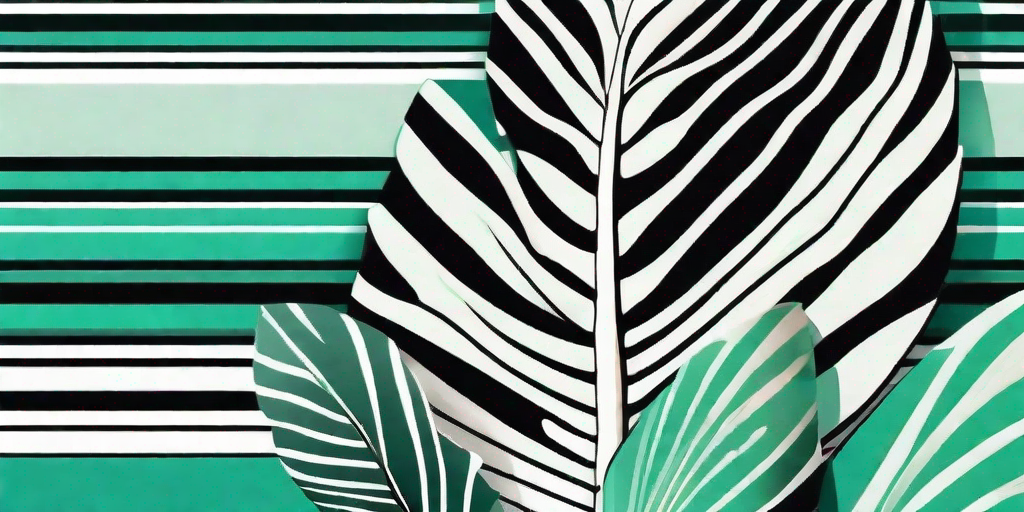
If you're looking to add a dash of the exotic to your garden, look no further than the Zebra Calathea. This striking plant, with its zebra-like stripes and vibrant green leaves, is sure to turn heads and make your garden the talk of the town. But, as with any wild beast, it needs the right care and attention to thrive. So, let's dive into the wild world of Zebra Calathea and discover how to tame this jungle beauty.
Understanding the Zebra Calathea
The Zebra Calathea, or Calathea zebrina, is a tropical plant native to Brazil. It's known for its large, oval-shaped leaves that feature striking light and dark green stripes, reminiscent of a zebra's coat. But don't worry, it won't bite! This plant is a gentle giant, reaching up to 3 feet in height and adding a touch of the tropics to any garden or indoor space.
But why choose a Zebra Calathea? Well, aside from its obvious good looks, this plant is also known for its air-purifying qualities. It's a natural air filter, removing toxins from the air and releasing fresh oxygen. So, not only will it make your garden look like a tropical paradise, but it'll also help you breathe a little easier too.
How to Grow a Zebra Calathea
Now that we've piqued your interest, let's get down to the nitty-gritty of growing a Zebra Calathea. While this plant may look wild and untamed, it's actually a bit of a diva when it comes to its growing conditions. But don't let that put you off! With a little care and attention, you'll have a thriving Zebra Calathea in no time.
Choosing the Right Spot
The Zebra Calathea is a bit of a Goldilocks when it comes to light. It doesn't like too much light, or too little, but just the right amount. So, choose a spot in your garden that gets indirect sunlight. Too much direct sunlight can scorch its beautiful leaves, while too little can cause them to lose their vibrant colour.
And remember, this is a tropical plant, so it likes it warm. Keep it away from draughty areas and make sure the temperature doesn't drop below 15°C (60°F). If you're growing it indoors, a spot near a window but out of direct sunlight is ideal.
Watering and Feeding
When it comes to watering, the Zebra Calathea likes to keep its feet wet, but not too wet. Overwatering can lead to root rot, which is as nasty as it sounds. So, water your plant when the top inch of soil feels dry to the touch, and make sure it has good drainage.
As for feeding, a good quality houseplant fertilizer every two weeks during the growing season (spring and summer) will keep your Zebra Calathea looking its best. Just remember to reduce feeding during the cooler months, as the plant's growth will slow down.
Caring for Your Zebra Calathea
So, you've got your Zebra Calathea planted and it's looking fabulous. But how do you keep it that way? Here are some tips for keeping your plant looking its best.
Pruning and Cleaning
Like any plant, the Zebra Calathea will benefit from a little TLC. Regularly remove any dead or yellowing leaves to keep the plant looking fresh and healthy. And don't forget to give the leaves a wipe every now and then to remove any dust. After all, a clean plant is a happy plant!
And while we're on the subject of cleaning, it's worth noting that the Zebra Calathea is a bit of a drama queen when it comes to water quality. It doesn't like tap water, so use filtered or rainwater if possible. If you must use tap water, let it sit for a day or two to allow the chlorine to evaporate before using it.
Dealing with Pests
Unfortunately, the Zebra Calathea's striking leaves can attract unwanted attention from pests like spider mites and aphids. Regularly check the leaves for signs of these pests and treat with a natural insecticide if necessary. And remember, prevention is better than cure, so keep your plant clean and healthy to deter pests in the first place.
Frequently Asked Questions
Why are the leaves on my Zebra Calathea curling?
Leaf curling is usually a sign of under-watering or low humidity. Try increasing the frequency of watering and misting the leaves to increase humidity.
Can I propagate my Zebra Calathea?
Yes, you can! Simply divide the plant at the roots during repotting and plant the divisions in separate pots. Just make sure each division has at least one healthy leaf.
Is the Zebra Calathea pet-friendly?
Good news for pet owners - the Zebra Calathea is non-toxic to cats and dogs. However, it's always best to keep plants out of reach of curious pets.
Conclusion
So there you have it, a comprehensive guide to unleashing the wild side of your garden with the Zebra Calathea. With its striking leaves and air-purifying qualities, it's a plant that's sure to make a statement. And with a little care and attention, you'll have a thriving Zebra Calathea that's the envy of all your friends. So why not give it a go? After all, who doesn't want a touch of the tropics in their garden?















